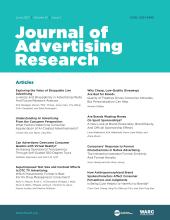Abstract
Perceived lack of authenticity and inferences of manipulative intent by an advertiser can impede an advertisement’s intended effect. This research posits that 360-degree virtual tours offer realistic content, thereby helping consumers to overcome such reservations. Using an operational-transparency framework, three studies show that 360-degree panoramic tours increase telepresence, improve authenticity, lower inferred manipulative intent, and stimulate approach intentions. Accounting for control variables—device, locus of control, mood, and processing style—adds evidence for the robustness of these effects across a number of individual and situational contexts. The findings offer initial insight on how advertisers can employ computer-mediated experiences to attract customers.
- Received September 26, 2018.
- Received (in revised form) September 30, 2019.
- Accepted October 24, 2019.
- Copyright © 2021 ARF. All rights reserved.
ARF MEMBERS
If you are a member of the Advertising Research Foundation, you can access the content by logging in here
Log In
Pay Per Article - You may access this article (from the computer you are currently using) for 30 days for US$20.00
Regain Access - You can regain access to a recent Pay per Article purchase if your access period has not yet expired.





